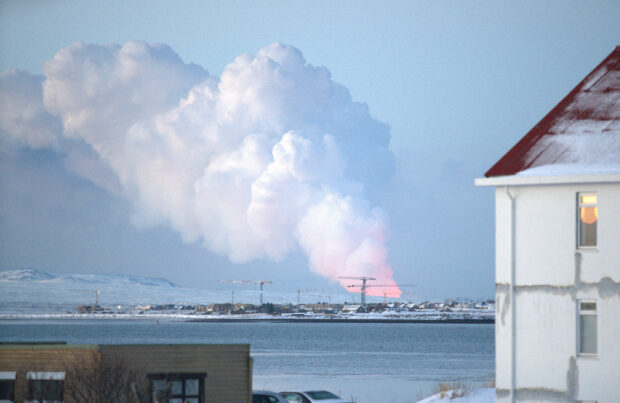
A volcanic eruption is seen in the distance from the Icelandic capital of Reykjavik, Iceland, February 8, 2024. An Iceland volcano eruption appeared to have ended on Friday, February 9, but left residents in the cold amid a trail of damage. REUTERS/ Frank Nieuwenhuis
BLUE LAGOON, Iceland — Iceland’s latest volcanic eruption appeared to have ended on Friday but left a trail of damage to roads and pipelines, cutting hot water to parts of the Reykjanes peninsula during freezing temperatures.
The eruption began on Thursday, spewing orange lava 80 meters (260 feet) high from a 3 km (2 miles) crack in the earth. However, by mid-day on Friday drone footage showed no signs of activity at the site.
“This suggests that the eruption is ending. Volcanic tremor is no longer being detected on seismic sensors,” the Icelandic Meteorological Office (IMO) said in a statement.
About 15 million cubic meters of molten rock had flowed from the ground in the first seven hours of the eruption, according to an IMO estimate on Friday.
It was the third eruption in the area, just south of the capital Reykjavik, since December.
READ: Iceland volcano erupts with lava fountains, disrupts heating and roads
The Blue Lagoon luxury geothermal spa, a tourist attraction, was closed to the public after lava covered its main access road, although the giant outdoor pool itself was unscathed, a Reuters eyewitness said after briefly being allowed to visit.
Schools, kindergartens, museums and other public institutions in the region were closed on Friday as the lava had hit hot water pipes used to supply geothermally-heated water.
“It is a very bad situation to have this area without hot water, but there is electricity, there is potable water,” Prime Minister Katrin Jakobsdottir told public broadcaster RUV.
The temperature in the area stood at -8 degrees Celsius (17.6 Fahrenheit) early on Friday.
Some 20 people had worked overnight to restore hot water via an emergency pipeline that was already under construction, utility HS Orka said in a post on Facebook.
Fissure eruptions
Authorities had previously hoped to restore supply during the day but this had now been delayed until midnight (GMT), the Civil Protection Authority said in a statement.
It could take up to two days to reach full pressure on the pipes, it said.
Unlike last month, when the town of Grindavik was hit, burning several houses to the ground, the latest outbreak did not damage any homes.
READ: Iceland volcano erupts again, molten rocks spew from fissures
Kopavogsbaer, a municipality on the outskirts of the capital Reykjavik, invited people from the impacted area to use their public swimming pools for free.
Satellite images published by the Icelandic Met Office showed lava flows had reached roughly 4.5 km (3 miles) to the west of the eruption, just some 500 metres (1,600 feet) from the Blue Lagoon spa which was evacuated on Thursday.
Volcanic outbreaks in the Reykjanes peninsula are so-called fissure eruptions, which do not usually cause large explosions or significant dispersal of ash into the stratosphere.
However, scientists fear they could continue for decades, and Icelandic authorities have started building dykes to divert burning lava flows away from homes and critical infrastructure.